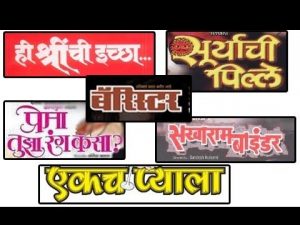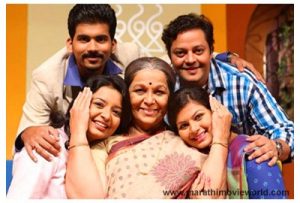Marathi Theatre has come a long way
 Marathi theatre has always been regarded as one of the most culturally rich theatre traditions in the country. Right from the 18th century the Marathi theatre has been present. It seems King Patwardhan of Sangli requested novelist Vishnu Bhave to write an evocative play for entertaining his guests and Bhave wrote ‘Sita Swayamvar’ which was performed on November 5, 1843, in that princely state. It was inspired by Karnataka’s folk theatre form of Yakshagana.
Marathi theatre has always been regarded as one of the most culturally rich theatre traditions in the country. Right from the 18th century the Marathi theatre has been present. It seems King Patwardhan of Sangli requested novelist Vishnu Bhave to write an evocative play for entertaining his guests and Bhave wrote ‘Sita Swayamvar’ which was performed on November 5, 1843, in that princely state. It was inspired by Karnataka’s folk theatre form of Yakshagana.
The Marathi stage has evolved in Bombay (now Mumbai) because this city has always been a business city; it had the infrastructure and money which helped the formal performers to grow. Because of the majority Maharashtrian workers community in the city who lived in the chawls the free time was used to practice dramas, keertans, pravachans and powadas. The artists used to practice in whatever space was available to them; sometimes varandahs, staircases and the open grounds. Lavanis such as “Mumbai Nagari Badi Banka, Jashi Ravanachi dusari Lanka” by Patthe Bapurao and Annabhau Sathe’s “Mazi Mumbai, Arthat Muumbai Konachi” were super duper hits those days. People flocked to the theatres to watch these lavanis.
 Maharashtra has had long theatrical tradition, one of its early references is found in cave inscriptions at Nashik. Marathi theatre started flourishing in the middle of the 19th century. It includes forms like Sangeet Natak (Musical drama), Tamasha (folk dance), Ekpatri prayog etc. It continues to have a marked presence in the State of Maharashtra. Marhathi theatre is not famous outside Maharashtra; maybe because Marathi as a language is quite difficult and a lot of stress is laid on the richness of the language by the writers; the gamut of Marathi dramas ranges from humorous social plays, farces, historical plays, musical, to experimental plays and serious drama. We have seen the likes of Annabhau Kirloskar, P. L. Deshpande, Vijay Tendulkar, and Mahesh Elkunchwar, Bhalaji Pendharkar, Raja Paranjape, Annabhu Sathe, Vinda Karandikar, Arun Sadhu, P. K. Atre, Daya Pawar etc who were known and are known even today for their par excellence. But, there is one big problem in staging a drama and continuing it for long time. We find Marathi dramas live a short life span, though some of them have great content. They are forgotten easily. Perhaps it is because Maharashtra faces multiculturalism and therefore the Marathi theatre takes a backset. Most importantly, Marathi theatre faces many political and social undercurrents. There is a sea change in terms of quality and context which are changing like never before. The conditions today cannot be compared to the previous decade.
Maharashtra has had long theatrical tradition, one of its early references is found in cave inscriptions at Nashik. Marathi theatre started flourishing in the middle of the 19th century. It includes forms like Sangeet Natak (Musical drama), Tamasha (folk dance), Ekpatri prayog etc. It continues to have a marked presence in the State of Maharashtra. Marhathi theatre is not famous outside Maharashtra; maybe because Marathi as a language is quite difficult and a lot of stress is laid on the richness of the language by the writers; the gamut of Marathi dramas ranges from humorous social plays, farces, historical plays, musical, to experimental plays and serious drama. We have seen the likes of Annabhau Kirloskar, P. L. Deshpande, Vijay Tendulkar, and Mahesh Elkunchwar, Bhalaji Pendharkar, Raja Paranjape, Annabhu Sathe, Vinda Karandikar, Arun Sadhu, P. K. Atre, Daya Pawar etc who were known and are known even today for their par excellence. But, there is one big problem in staging a drama and continuing it for long time. We find Marathi dramas live a short life span, though some of them have great content. They are forgotten easily. Perhaps it is because Maharashtra faces multiculturalism and therefore the Marathi theatre takes a backset. Most importantly, Marathi theatre faces many political and social undercurrents. There is a sea change in terms of quality and context which are changing like never before. The conditions today cannot be compared to the previous decade.
Marathi Theatre can be described as never-ending energy; live moments, live interaction, superb dialogues, and great backdrops of stage, superb background music scores, and a strong tradition of 150 years which can never die. Besides, Marathi dramas are sharp, witty and very rich in content. They make you think even hours after you’ve watched a show. Marathi theatre is evolving with newer ideas, newer concepts and much more experiments. The new breed of directors is experimenting with forms of theatre. No other place in India has so much of ‘commercial theatre’ like that in Maharashtra. If you have three movie shows in Plaza, the theatre bang opposite to it, Shivaji Mandir, has three shows of plays on the same day.
The various genres of Marathi scripts are also a reason for people to watch plays. Comedy, serious depiction of the society, political satires, musicals, romantic, tragedy, rags to riches stories and mission – it has it all. Marathi theatre fascinates its viewers with its large variety.
The cultural connection of Mumbai and Pune with its regional theatre shows that the stage is not dying, it is experimenting and it has long way to go. It has managed to carve a special niche and that’s reason enough to say that there’s plenty of hope for the art in the state of Maharashtra.
Both cinema and drama are based on story. Both drama and cinema depend primarily on performers who resent and communicate the story to the audience. A stage play or a screenplay is like reading a novel. Dramas are livelier and thrilling as you see the actor’s performance right in front. The audience can clap and applaud the actors on the stage. The actors also in response give their best dialogue delivery, voice modulation, gestures thus bringing in more energy in the theater. Drama is on the spot. There are not takes and retakes; it delivers effect on the spot therefore it connects with the viewers more honestly. Drama is more difficult for an actor.
 Both drama and cinema share certain common features; they both use sets, props, costumes, music and other sound effects. Communication is the essence in both drama and cinema. Even in the silent era, films relied heavily on human speech that was understood through contextual instinct; a combination of gesture, facial expression, and lip reading; and inserts of printed, projected text. If a drama is dull or boring viewers crate a commotion whereas if a cinema is boring they simply walk out of the theatre. Bothe cinema and drama have their fan following. Everybody cannot enjoy drama; an audience that has been raised on films, do not enjoy dramas.
Both drama and cinema share certain common features; they both use sets, props, costumes, music and other sound effects. Communication is the essence in both drama and cinema. Even in the silent era, films relied heavily on human speech that was understood through contextual instinct; a combination of gesture, facial expression, and lip reading; and inserts of printed, projected text. If a drama is dull or boring viewers crate a commotion whereas if a cinema is boring they simply walk out of the theatre. Bothe cinema and drama have their fan following. Everybody cannot enjoy drama; an audience that has been raised on films, do not enjoy dramas.
Marathi theatre has come a long way. While Gujarati, Hindi or English theatre is ‘merely weekend theatre’, catering to the thinking and upper class, Marathi theatre is all about the masses mainly because of the way it gets people to relate to the script. Mumbai and Pune are hubs of Marathi plays. In Mumbai and Pune, there are these niche classes of people who usually do not miss watching a play every week. Mumbai is the economic capital and Pune is the cultural capital of Maharashtra state. There are at least 15-20 theatres in Mumbai which host only Marathi plays right from Prabhadevi to Thane: Rabindra Natya Mandir, Shivaji Natya Mandir, Ranga Sharda, Dinanath, Gadkari Rangayatan and many more theatres are witness to the love Mumbaikars have for this art form. And in Pune: Bal Gandharva Rang Mandir, Tilak Smarak Mandir, Bharat Natya Mandir, Sudarshan Hall, Moreshwar Hall, Yashwantrao Chavan Natya Mandir etc are famous for Mrathi drama lovers. Mumbai and Pune showcase the love for performing art relatively much more, compared to other cities like Bangalore or New Delhi which relatively have fewer auditoriums.
The amount of theatre that is being done on the commercial as well as parallel stage in Marathi cannot be compared to any other regional theatre today. It is facing some technical, political and financial problems today, which I am sure, will be sorted out sooner or later. The Marathi theatre scene is the most happening in the whole of India.













































